

Johns Hopkins University (JHU) continues to pad its space community résumé with their interactive map, “The map of the observable Universe”, that takes viewers on a 13.7-billion-year-old tour of the cosmos from the present to the moments after the Big Bang. While JHU is responsible for creating the site, additional contributions were made by NASA, the European Space Agency, the National Science Foundation, and the Sloan Foundation.
It's been seven years since Oumuamua flew through our Solar System. In that time, theories have come and gone, but here's why the first Interstellar UFO almost certainly had an artificial origin! #space #uap #alien Please support my journey to the Cape!! DISCORD MEMBERSHIP, EXCLUSIVE CONTENT AND EARLY RELEASES PLUS 15% OFF MERCH! Support the Angry Astronnaut on patreon donate via a qr code!! Support the Angry Astronnaut on Pay Pal Follow me on twitter Support Jenined! a ufo research page / @jenined
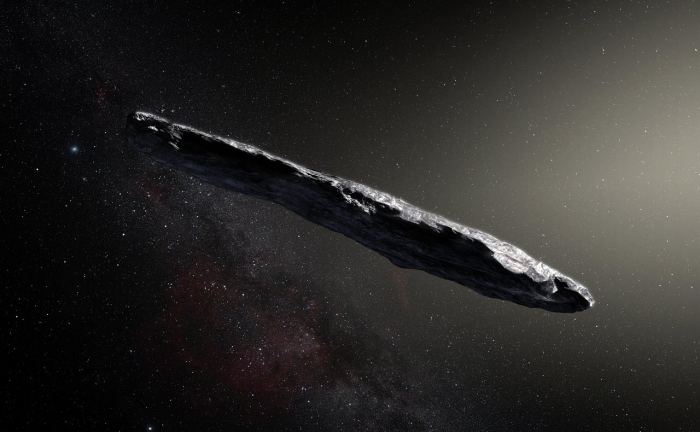
Artist’s impression of the first interstellar asteroid, "Oumuamua".(1I/2017 U1 ) This unique object was discovered on 19 October 2017 by the Pan-STARRS 1 telescope in Hawaii. Credit: ESO/M. Kornmesser
The Object That Shouldn’t Exist: Alien Technology or Not? ► Subscribe: To Desiny's youtube channel In 2017, astronomers spotted something that shook the scientific world: an object from deep space, moving too fast to be bound by our Sun. It didn’t behave like a comet or asteroid. No tail, strange shape, sudden acceleration — and then it vanished into the dark. They called it ‘Oumuamua — “the scout.” But what was it really? Some believe it was a natural anomaly. Others think it could be a spacecraft from another civilization. Now, a daring mission — Project Lyra— is being planned to chase it down and uncover the truth. This is the story of the strangest visitor our Solar System has ever seen.
In a way, it doesn't matter whether it was a shard of alien technology or a strangely shaped chunk of ice. What matters is that it opened a door. It stretched the boundaries of what we imagine might be possible. Because one object slipping past doesn’t change the universe. It just changes us. It reminds us that the biggest discoveries aren’t always in the headlines or the textbook definitions. Sometimes they’re in the quiet moments, when something unexpected appears, and we have to decide whether to look away... or to chase it. 0:00 Introduction 0:55 First Sighting 2:56 What Made It So Strange? 5:48 The Impossible Acceleration 11:06 Avi Loeb’s Perspective: A Challenge to Conventional Wisdom 16:42 Battle of the Theories: Natural Explanations Fight Back 22:26 New Clues Closer to Home: Dark Comets in Our Own Solar System 26:51 Other Interstellar Visitors: Not Just One Strange Object 30:52 Where Did It Come From? The Impossible Origins 34:42 The Race to Catch ʻOumuamua: Is It Still Possible? 36:49 Future Interstellar Interlopers: Preparing for the Next One 40:57 The Deeper Meaning: Why ʻOumuamua Still Matters 44:48 Final Reflection
#astrum #astronomy #space As Oumuamua leaves our solar system, we explore the reasons for continuing the chase. 🔒Remove your personal information from the web at and use code ASTRUM for 20% off 🙌 DeleteMe international Plans: A huge thanks to our Patreons who help make these videos possible. Sign-up here: Patreon: Astrum Podcast: Displate Posters: Astrum Merch! Join the official Astrum discord server: SUBSCRIBE for more videos about our other planets. Subscribe! Facebook! Twitter! Astrum Hindi: Astrum Spanish: Credits Writer: Julia Masselos Editor: Nathália Huzian Thumbnail Designer: Peter Sheppard Producer(s): Alex McColgan / Raquel Taylor NASA/ESO/ESA
This animation of an artist's concept shows the interstellar asteroid 1I/2017 (`Oumuamua). Observations with ESO's Very Large Telescope and others have shown that this unique object is dark, reddish in colour and highly elongated. More information and download options:
For the first time ever astronomers have studied an asteroid that has entered the Solar System from interstellar space. Observations from ESO’s Very Large Telescope in Chile and other observatories around the world show that this unique object was travelling through space for millions of years before its chance encounter with our star system. It appears to be a dark, reddish, highly-elongated rocky or high-metal-content object.The video is available in 4K UHD. The ESOcast Light is a series of short videos bringing you the wonders of the Universe in bite-sized pieces. The ESOcast Light episodes will not be replacing the standard, longer ESOcasts, but complement them with current astronomy news and images in ESO press releases. More information and download options: Subscribe to ESOcast in iTunes! Receive future episodes on YouTube by pressing the Subscribe button above or follow us on Vimeo: : Watch more ESOcast episodes Find out how to view and contribute subtitles for the ESOcast in multiple languages, or translate this video on YouTube: Credit: ESO Category Science & Technology License Creative Commons Attribution license (reuse allowed) SHOW LESS
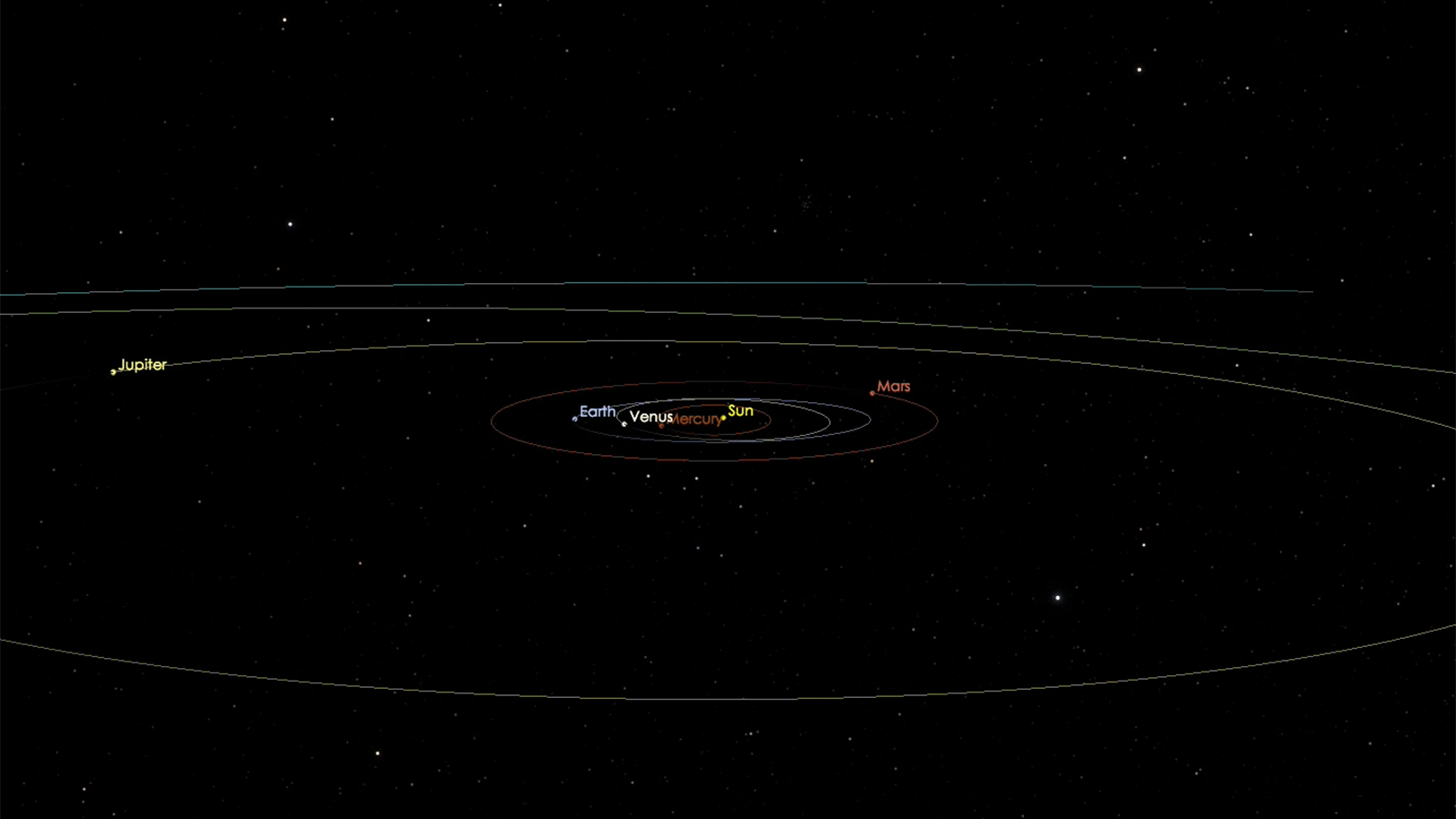
vesta This animation shows the path of 1I/2017 U1, or ‘Oumuamua, as it passed through our inner solar system in September and October 2017. From analysis of its motion, scientists calculate that it originated from outside of our solar system. Credit: NASA/JPL-Caltech
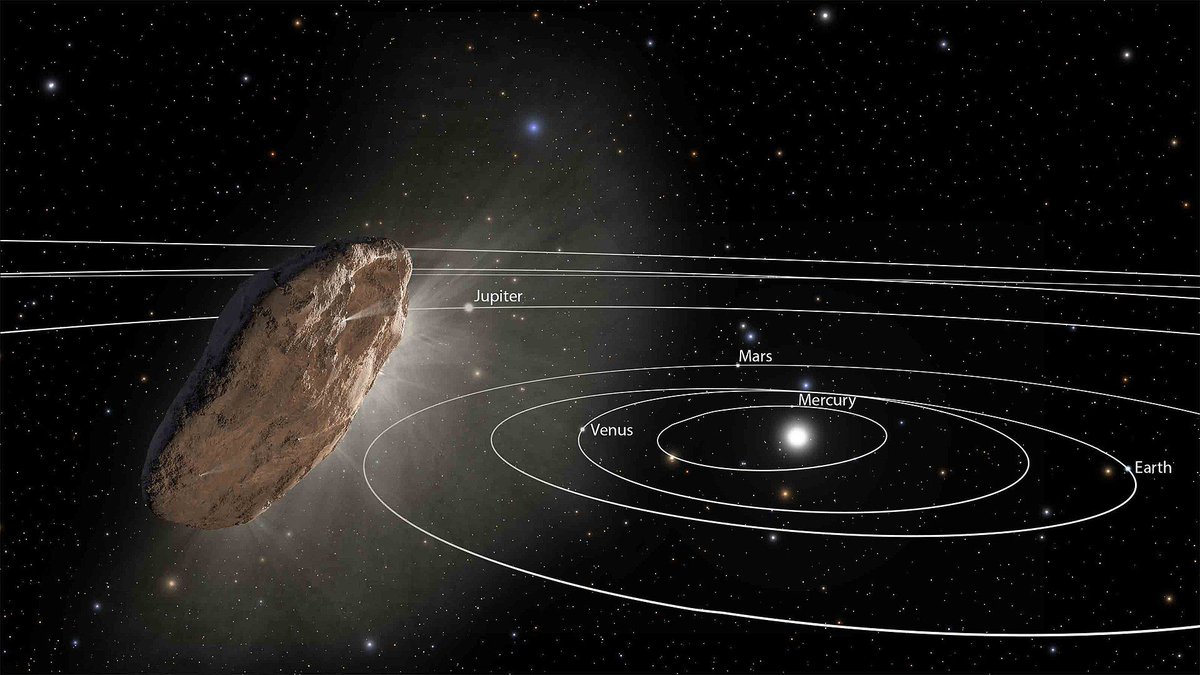
On October 19th, 2017, the Panoramic Survey Telescope and Rapid Response System-1 (Pan-STARRS-1) in Hawaii announced the first-ever detection of an interstellar object, named 1I/2017 U1 (aka. ‘Oumuamua). In the months that followed, multiple follow-up observations were conducted to learn more about this visitor, as well as resolve the dispute about whether it was a comet and an asteroid.
This small object was discovered on October 19, 2017, by the University of Hawaii's Pan-STARRS 1 telescope on Haleakala, Hawaii. Subsequent observations by ESO’s Very Large Telescope and other telescopes showed that it had come to the Solar System from interstellar space. 1I/`Oumuamua made its closest approach to the Sun on September 9, 2017. Its hyperbolic orbit is highly inclined and it does not appear to have come close to any other Solar System body on its way in. 1I/`Oumuamua is now on its way out of the Solar System. 1I/2017 U1 seems to be a dark red highly-elongated metallic or rocky body, about 400 meters long. Before receiving the official designation and name `Oumuamua from the International Astronomical Union it was referred to as A/2017 U1 The name was chosen by the Pan-STARRS team. It is of Hawaiian origin and means "a messenger from afar arriving first." Credit: ESO, M. Kornmesser, L.Calcada. Music: Azul Cobalto (soundcloud.com/azul-cobalto) Related: Small Asteroid or Comet 'Visits' from Beyond the Solar System: youtu.be/XD6QCgzwFAA
Astronomers have found that ‘Oumuamua, the first interstellar object discovered in the Solar System, is moving away from the Sun faster than expected. Using data from ESO’s Very Large Telescope, and from NASA/ESA’s Hubble Space Telescope, a team of researchers concluded that ‘Oumuamua is most likely outgassing — suggesting that this enigmatic interstellar nomad is a peculiar comet rather than an asteroid. More information and download options: Subscribe to ESOcast in iTunes! Receive future episodes on YouTube by pressing the Subscribe button above or follow us on Vimeo: Watch more ESOcast episodes: Find out how to view and contribute subtitles for the ESOcast in multiple languages, or translate this video on YouTube: Credit: ESO Directed by: Mathias Jäger. Visual Design and Editing: Martin Kornmesser and Luis Calçada. Editing: Martin Kornmesser. Web and technical support: Mathias André and Raquel Yumi Shida. Written by: Calum Turner and Mathias Jäger. Music: Stellardrone. Narration: Sara Mendes da Costa. Footage and photos: ESO, ESA/Hubble NASA, ESA, Luis Calçada , M. Kornmesser and G. Hüdepohl (atacamaphoto.com). Executive producer: Lars Lindberg Christensen. Caption author (Slovak) Mac Ownick Caption author (Italian) Nicola Gaspari Caption author (French) Ayoola Boyejo Caption author (Romanian) Mihail-Gabriel Barbuta Caption author (Polish) Tomasz Kozłowski Category Science & Technology License Creative Commons Attribution license (reuse allowed)

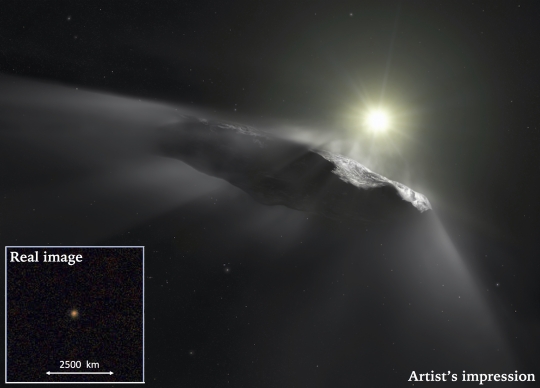
Image: This artist’s impression shows the first interstellar object discovered in the Solar System, ʻOumuamua. Observations made with the NASA/ESA Hubble Space Telescope, CFHT, and others, show that the object is moving faster than predicted while leaving the Solar System. The inset shows a color composite produced by combining 192 images obtained through three visible and two near-infrared filters totaling 1.6 hours of integration on October 27, 2017, at the Gemini South telescope. Credit: ESA/Hubble, NASA, ESO/M. Kornmesser, Gemini Observatory/AURA/NSF.

Artist’s conception of ‘Oumuamua. Credit – M. Kornmesser/ESO/NASA
Get an email announcement whenever we release a new video: On October 25, 2017, astronomers from NASA’s Minor Planet Center sent out an announcement that they needed help confirming the trajectory of an interesting object. Known as C/2017 U1 PANSTARRS, the object was moving quickly through the Solar System, on a path that would take it out into deep space. Astronomers were happy to oblige, providing dozens of observations within a few days, confirming that yes indeed, we were looking at the first asteroid that had come from interstellar space. Follow us on Twitter: @universetoday Like us on Facebook: Instagram - Support us at:Support us at: Instagram - Team: Fraser Cain - @fcain / frasercain@gmail.com /Karla Thompson - @karlaii Chad Weber - Chloe Cain - Instagram: @chloegwen2001 Chloe Cain - Instagram: @chloegwen2001 Music: Left Spine Down - “X-Ray” Team: Fraser Cain - @fcain / frasercain@gmail.com Karla Thompson - @karlaii / Karla Thompson's youtube channel Chad Weber - weber.chad@gmail.com Chloe Cain - Instagram: @chloegwen2001 It turns out that C/2017 U1 PANSTARRS, later given the Hawaiian name Oumuamua, or “a messenger from afar arriving first”, had already made its closest pass to the Sun on September 9th, 2017, traveling at a top speed of 87.4 kilometers per second. It whipped around the Sun, and then continued on its hyperbolic orbit out into deep space again. It passed near the Earth on October 14, then crossed the orbit of Mars on November 1st, by May 2018 it’ll be farther than Jupiter, and get past Saturn in early 2019. Astronomers around the world have been making continuous observations of the asteroid, using some of the largest telescopes on Earth and in space. But they’ve got to work quickly, by mid-December, it’ll be too dim to observe with any of our instruments.
Professor Avi Loeb is a theoretical physicist from Harvard who has worked on many advances in space and astrophysics. He helped predict exoplanet discoveries using microlensing, worked on the mathematics for the Event Horizon Telescope, and has many fascinating opinions about the search for extraterrestrials. Avi Loeb's Harvard Webpage 🚀 OUR WEBSITE: ════════════════════════════════════ 🚀 OUR WEBSITE: 🚀 PODCAST LINKS: ════════════════════════════════════ RSS: iTunes: Spotify 🚀 EMAIL NEWSLETTER: ════════════════════════════════════ Read by 50,000 people every Friday. Written by Fraser. No ads. Subscribe Free: 🚀 OTHER PODCASTS: ════════════════════════════════════ Weekly Space Hangout: Weekly news roundup with Fraser, special guests, and other space journalists. RSS: iTunes: YouTube: Astronomy Cast: Award-winning, long-running deep dive into space and astronomy with Fraser and Dr. Pamela Gay. RSS: iTunes: YouTube: 🚀 JOIN OUR COMMUNITY: ════════════════════════════════════ Patreon: 🚀 OTHER SOCIAL MEDIA: ════════════════════════════════════ Twitter: Twitter: Facebook: Instagram: Twitch: 🚀 CONTACT FRASER: ════════════════════════════════════ CONTACT FRASER: via Email: 🚀 LICENSE: ════════════════════════════════════ Creative Commons Attribution 4.0 International (CC BY 4.0) You are free to use my work for any purpose you like, just mention me as the source and link back to this video.
Audio Audio Podcast version:ITunes: : RSS Video Video Podcast version:ITunes: RSS:
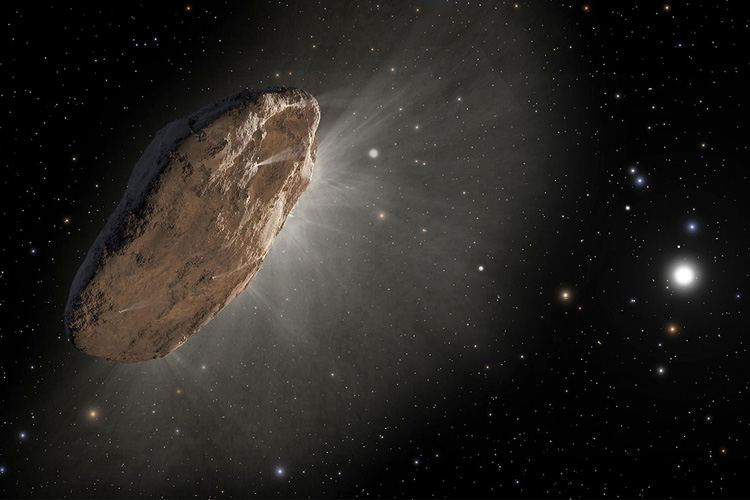
An artist’s depiction of the interstellar comet ‘Oumuamua, as it warmed up in its approach to the sun and outgassed hydrogen (white mist), which slightly altered its orbit. The comet, which is most likely pancake-shaped, is the first known object other than dust grains to visit our solar system from another star. (Image credit: NASA, ESA and Joseph Olmsted and Frank Summers of STScI)
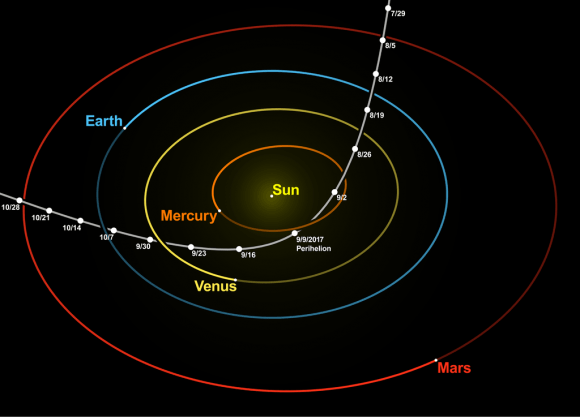
Hyperbolic trajectory of ?Oumuamua through the inner Solar System, with the Sun at the focus, showing its position every 7 days. The planet positions are fixed at the perihelion on September 9, 2017. Shown from a three-quarter perspective, roughly aligned to the plane of ?Oumuamua’s path. Credit: Tomruen, CC BY-SA 4.0.
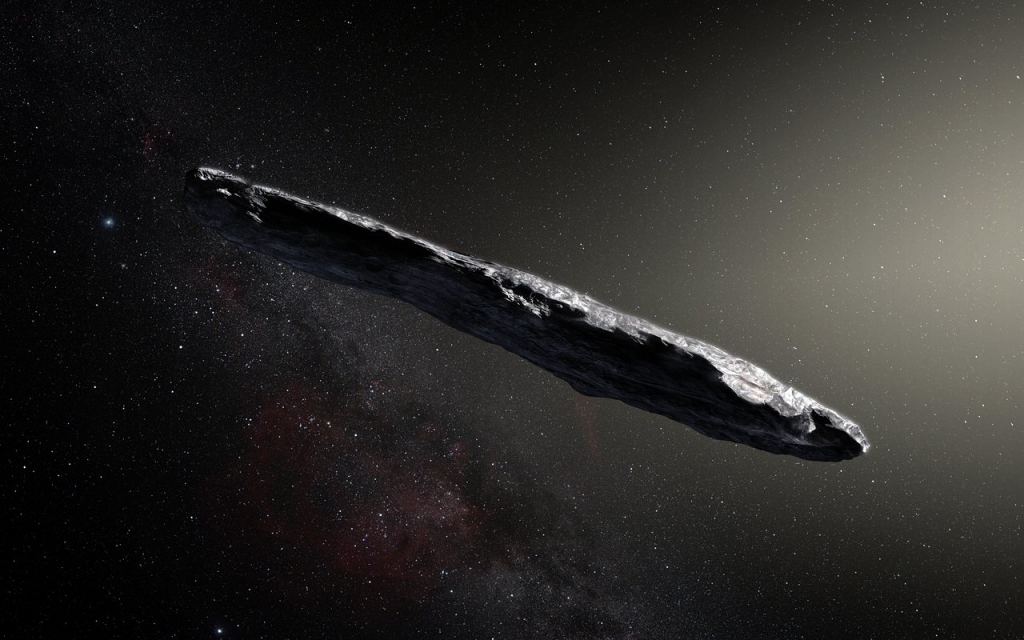
Artist’s impression of the first interstellar asteroid/comet, "Oumuamua". This unique object was discovered on 19 October 2017 by the Pan-STARRS 1 telescope in Hawaii. Credit: ESO/M. Kornmesser
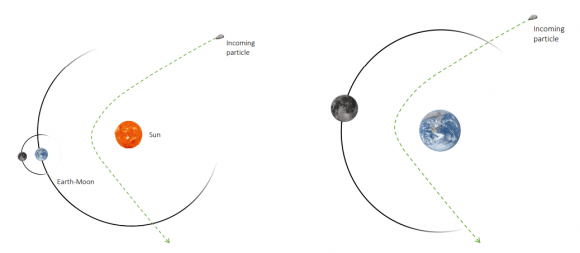
This figure from the study illustrates some of the particle simulations in the research. In their first scenario, the simulated system only consists of the Sun and the Earth-Moon system. Its purpose was to isolate the effect of giant planets. Image Credit: Mukherjee et al. 2023.
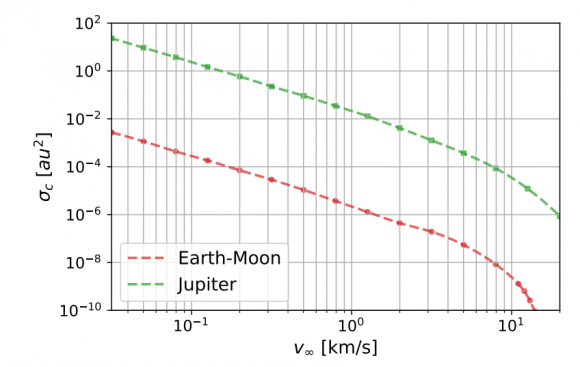
This figure from the research compares Jupiter’s efficacy at capturing ISOs into near-Earth orbits compared to the Earth-Moon efficacy. The math is fairly complex, but basically, the x-axis shows excess hyperbolic velocity, and as that rises, capture efficiency decreases. Image Credit: Mukherjee et al. 2023.

This figure from the research shows the distribution of orbital parameters for known small Solar System bodies vs captured ISOs. The left panel shows Astronomical Units, the middle panel shows orbital eccentricity and the right panel shows inclination. Image Credit: Mukherjee et al. 2023.
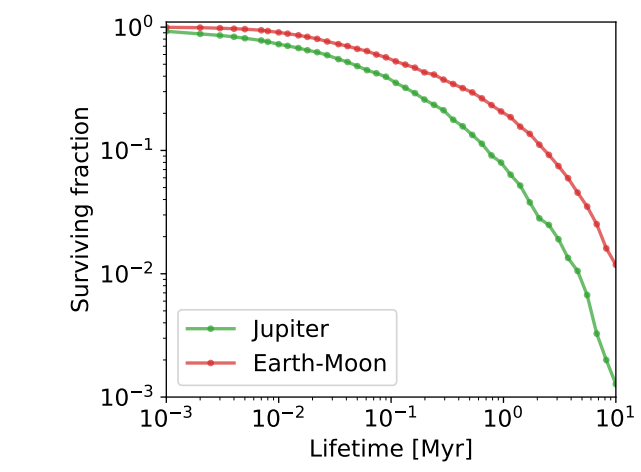
This figure from the study shows the survival fraction of captured interstellar NEOs as a function of the lifetime in bound NEO orbits. It shows that only 0.1-1% of the captured objects survive in NEO orbits by 10 Myr, which is significantly shorter than the lifetime of known NEOs. Image Credit: Mukherjee et al. 2023.
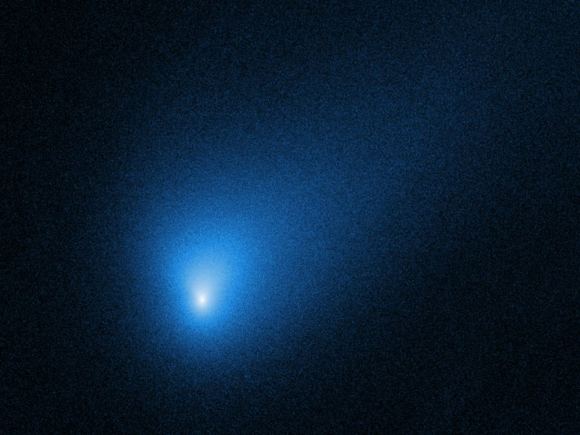
A Hubble image of Comet 2IBorisov from October 2019. Its size was difficult to determine because it never came closer than about 300 million km. Early estimates suggest it was anywhere between 1.4 to 16 km in diameter but later estimates shrunk that down to 0.5 km. Image Credit: By NASA, ESA, and D. Jewitt (UCLA) – Image Credit: By NASA, ESA, and D. Jewitt (UCLA) –
Astronomers speculate that Comet Hyakutake, which passed through the inner Solar System in 1996, is a captured ISO. Image Credit: By Franz Haar – Own work, CC BY-SA 3.0,
On the Rotation Period and Shape of the Hyperbolic Asteroid 1I/‘Oumuamua (2017 U1) from Its Lightcurve (PDF) Matthew M. Knight , Silvia Protopapa, Michael S. P. Kelley , Tony L. Farnham , James M. Bauer, Dennis Bodewits , Lori M. Feaga, and Jessica M. Sunshine University of Maryland, 1113 Physical Sciences Complex, Building 415, College Park, MD 20742-2421, USA; mmk8a@astro.umd.edu Received 2017 November 3; revised 2017 November 22; accepted 2017 November 25; published 2017 December 12
Three years ago, we detected the first interstellar object passing through the Solar System, `Oumuamua. Ever since, astronomers have been debating the origins of this strange body. Whilst many hypothesize an asteroid, the media is ablaze with the possibility that it could be alien technology. Join us today for a discussion of this theory and the counter-arguments proposed. Written & presented by Prof David Kipping. Thanks to Dr Sean Raymond for fact checking - check out his blog www.planetplanet.net and astro poetry book https://www.amazon.com/dp/B08LFZZWGZ You can now support our research program and the Cool Worlds Lab at Columbia University: Get Stash here! Thank-you to our supporters K. Clark, T. Widdowson, D. Smith, S. Hackley, M. Sloan, L. Sanborn, K. Kantor, P. Herman, C. Bottaccini, D. Brunk, D. Daughaday, S. Fincher, J. Kindred, A. Jones, J. Allen, S. Baldwin, J. Black, S. Brownlee, D. Denholm, T. Dorais, G. Downton, E. Urrestarazu, G. Fulton, S. Griffiths, P. Halloran, J. Jurcevic, N. Kildal, J. Kobernick, W. Kobernick, V. Kremer, M. Lijoi, S. Loftin, B. Loizides, A. Maslyanchuk, B. Matson, O. Mcintyre, L. Mitchell, A. Pelletier, J. Rivillas, B. Robinson, Z. Star, L. Steely, E. Stefan-Matyus, M. Steven, E. West, B. York, T. Zanjonc, P. Gowd, S. Kelsey, P. Kommareddy, C. Wolfred, D. Vennel, E. Dessoi, F. Naeem, F. Rebolledo, H. Laging, J. Falls, P. Rutherford, T. Leger, L. Skov, D. Roberts, E. Wilson, I. Baskerville, J. Bassnett, J. Shackleford, I. Johnstone, G. Suter, I. Hopcraft, J. Valdes, P. Akrill-Misso, W. Robertson, E. Orman, G. Ingham, D. Van Hecke, J. Pilloff, T. Bernhard. D. Dianovszki, E. Cook, S. Mass, T. Richards, T. Lancaster, C. Stouffer, G. Benson, A. de Vaal, C. Diamantis, J. Wenzel, M. Elliot, M. Wallstab, S. Bialek, B. Thomson, B. Daniluk, B. Bowen, D. Jacobson, D. Lukens, G. Coogan, J. Bushong, M. Wacinski, M. O'Donnell, M. Forbes, S. Vystoropskyi, S. Carr, T. Laird, S. Lee, T. Tschopp W. van den Wollenberg, Z. Danielson, Z. Turner, E. Fernandes, E. Vinci, L. Holc, S. Grant, S. Seyer, J. Patrick-Saunders, P. Conroy, R. Clifton, C. Butler, M. Peraic, N. Cordova, P. Inkpen & K. Uyemura. ::References:: ► Loeb, A., 2018, "Six Strange Facts About`Oumuamua", Scientific American: ► The 'Oumuamua ISSI Team, 2019, "The Natural History of 'Oumuamua", Nature Astronomy, 3, 594: ► Bialy, S. & Loeb, A., 2018, "Could Solar Radiation Pressure Explain ‘Oumuamua’s Peculiar Acceleration?", ApJ, 868, 1: ► Siraj, A. & Loeb, A., 2019, "‘Oumuamua's Geometry Could Be More Extreme than Previously Inferred", RNAAS, 3, 15: ► Zhang, Y. & Lin, D., 2020, "Tidal fragmentation as the origin of 1I/2017 U1 (‘Oumuamua)", Nature Astronomy, 4, 852: ► Engelhardt, T. et al., 2017, "An Observational Upper Limit on the Interstellar Number Density of Asteroids and Comets", AJ, 153, 133: ► Meech, K., et al., 2017, "A brief visit from a red and extremely elongated interstellar asteroid", Nature, 552, 378 ::Clips used:: See shorturl.at/glFLR ::Music:: ► "My Unbelief" by Hill licensed via SS ► "Cylinder Two" and "Cylinder Four" by Chris Zabriskie licensed under a CC Attribution license: ► "Painted Deserts" by Shimmer licensed via SS ► "Cylinder Five" by Chris Zabriskie licensed under a CC Attribution license: ► "Stories About The World That Once Was" and "We Were Never Meant to Live Here" by Chris Zabriskie : licensed under a CC Attribution license ► "Y" by Joachim Heinrich licensed under a CC Attribution license: ► "Human Nature" by Hill, used with permission from the artist: ► "Trace Correction" by Indive licensed under a CC Attribution license: 0:00 Six Strange Facts 6:27 Fact 1 8:19 Fact 2 10:35 Fact 3 12:10 Fact 4 16:31 Fact 5 17:19 Fact 6 19:43 Conclusion
------------------------------------------ Today, I am thrilled to have a very special guest joining me, Dr. Avi Loeb. Dr. Loeb is a theoretical physicist and the Frank B. Baird Jr. Professor of Science at Harvard University, where he is the former chair of the Astronomy Department. He is also the author of numerous articles and books on astrophysics, cosmology, and the search for extraterrestrial life. Dr. Loeb discusses the enigma of Oumuamua, the mysterious interstellar object that captured the world's attention in 2017. Dr. Loeb has been at the forefront of the scientific investigation of Oumuamua. Avi shares some of his insights on what this strange visitor might reveal about the nature of our universe and our place in it. We also discuss how Avi’s peers and the Scientific community, in general, responded to the possibility of Alien technology. But our conversation will not be limited to astrophysics alone. Dr. Loeb is a champion of scientific curiosity, humility, and exploration, and he will talk about how these values have shaped his career and his approach to life. We will also touch on what he calls the three coming revolutions of AI Sentience, Longevity, and the discovery of Advanced Civilizations. AI and Aliens – what could go wrong So, join us for a fascinating and wide-ranging conversation with one of the most brilliant and visionary scientists of our time. Please enjoy Dr. Avi Loeb. Thank you for visiting our channel, be sure to Like, Comment, and Subscribe! For more information, go to Learn More about QTS Data Centers on the Think you have a great topic for a podcast or would like to schedule an interview with Dave? Send in your requests to podcast@qtsdatacenters.com
Head to to save 10% off your first purchase of a website or domain using code eventhorizon In 2017, astronomers identified 1I/‘Oumuamua as the first interstellar object ever observed in our Solar System. While it lacked typical cometary activity, ‘Oumuamua exhibited a notable non-gravitational acceleration, leaving experts struggling to explain its origins. Previous models suggested outgassing of hyper-volatile molecules, but inconsistencies remained. In this video, we explore a new theory, by Dr. Jennifer Bergman and Darryl Seligman, that proposes ‘Oumuamua's acceleration was caused by the release of entrapped molecular hydrogen, which formed from energetic processing of an H2O-rich icy body. Acceleration of 1I/‘Oumuamua from radiolytically produced H2 in H2O ice Dark Comets? Unexpectedly Large Nongravitational Accelerations on a Sample of Small Asteroids More JMG Want to support the channel? : Patreon Follow us at other places! @JMGEventHorizon Music featured on Event Horizon Stellardrone Bandcamp Miguel Johnson Leerosevere bandcamp Aeriumambient Bandcamp
#interstellar #oumuamua #mystery NASA Scientists' Shocking New Revelation About 'Interstellar Spaceship' Oumuamua By the 2010s, astronomers had spent decades looking for objects from outside our own solar system. What would essentially be interstellar visitors from an alien star system. But to no avail. But it is when all hope seems to be lost, that some of the most marvelous things happen. It was something like that for these astronomers. After decades of finding absolutely nothing, multiple objects started arriving in our solar system. Scientists and astronomers from across the world, SETI and even NASA joined in the study of these mysterious visitors. One of the very first to arrive, was Oumuamua. Now a new revelation about the interstellar visitor has emerged. Subscribe to Orbit - / @orbit_btb